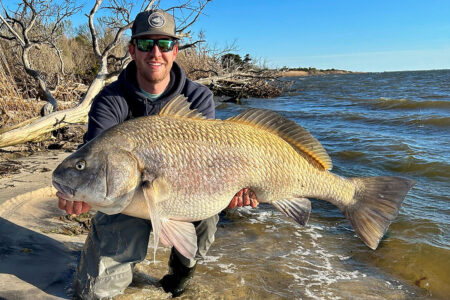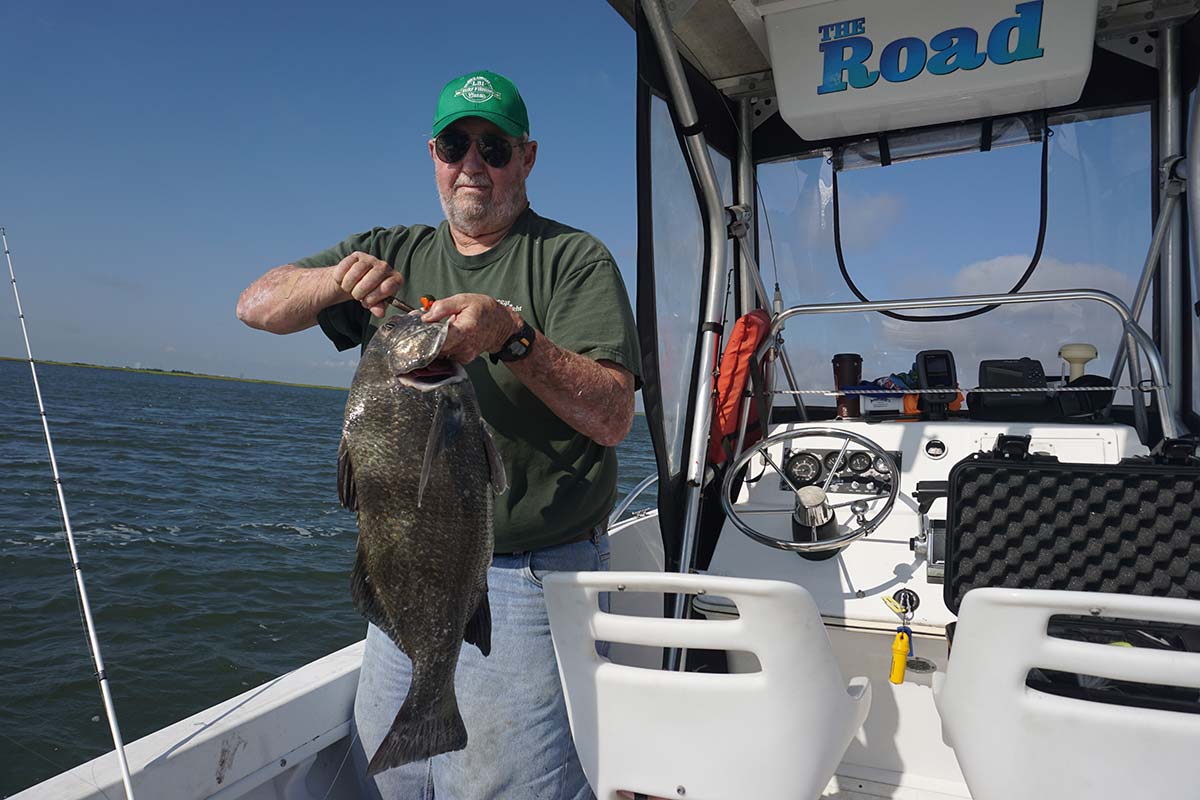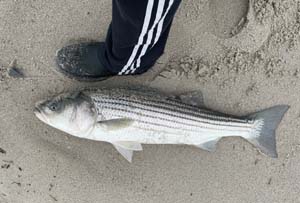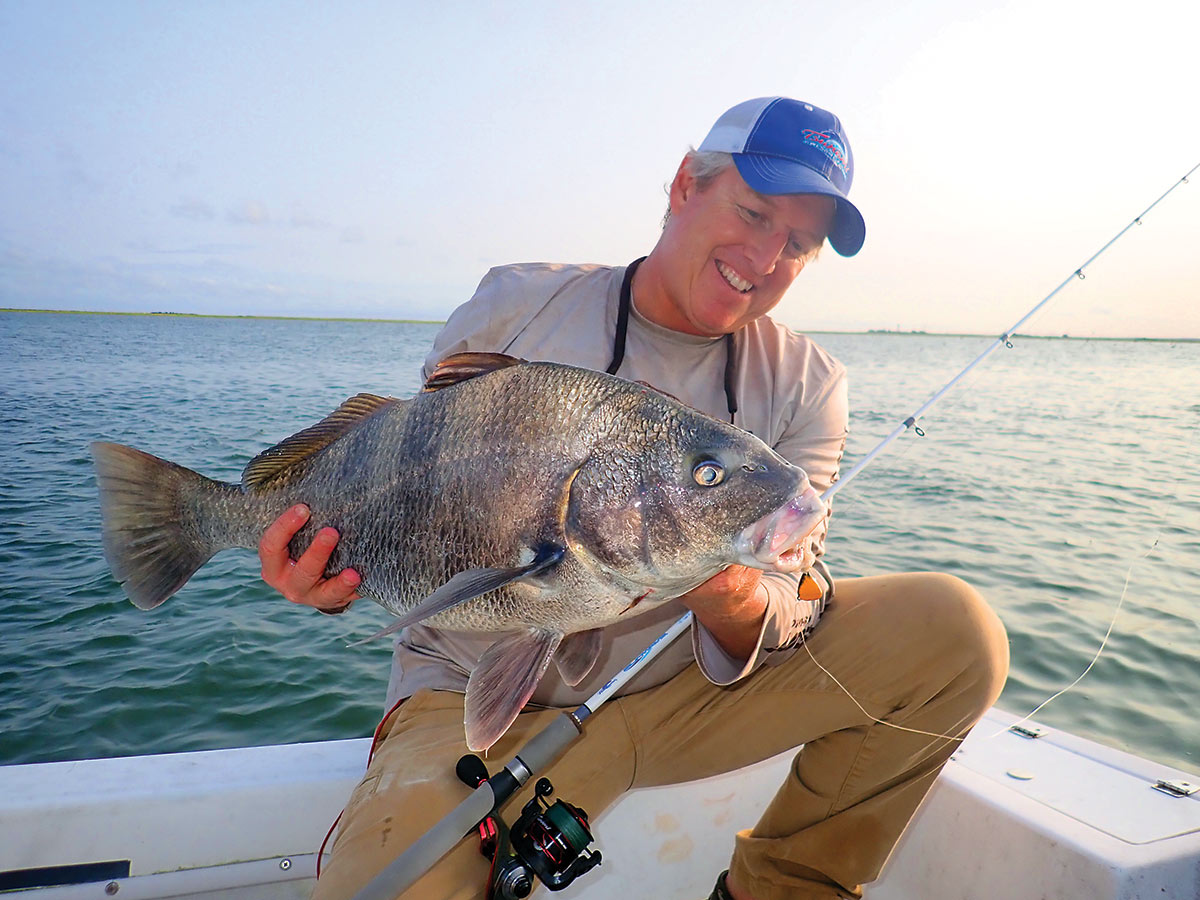
Blooming dogwoods, booming drum, and a “boon” to Jersey anglers looking to compete this season.
As the International Game Fish Association (IGFA) described it, Gerald Townsend launched his 12-foot boat on Delaware Bay on September 15, 1975 towards Cape Henlopen State Park in Delaware for a relaxing afternoon of fishing with his wife. Using 25-pound Trilene mono and cut mullet on a single-hook bottom rig, Townsend’s first fish took the bait and hit like a freight train, peeling off just about every piece of line from his trusty old conventional.
“Having good equipment paid off using my trusty PENN Squidder 140 and Hatteras Heaver surf rod,” Townsend said later following a 30-minute battle with his mystery fish, ultimately beaching a monster 113-pound, 1-ounce, IGFA world record black drum.
There were actually quite a few monster drum weighed in during a two-year stretch in the 1970s. Prior to Townsend taking the IGFA all-tackle world record that September day at the tip of Cape Henlopen, G. Hopkins had his 111-pounder in the IGFA record books for a little over a year, a fish landed off Cape Charles, VA in May of 1974; that was a record he shared with Bettie Drummond Hall who also had one of 111 pounds in that same port in May the prior year.
What’s strange of course is that the world record was bycatch; an accidental hook-up in the fall, months after the local fleet had stopped targeting the big boomers of spring.
“For many anglers, drum fish are an exciting fish to target or catch incidentally,” noted Joshua Freeman with the New Jersey Division of Fish and Wildlife (DFW) Bureau of Marine Fisheries. “Drum fish are likely to be caught by anyone who is bottom fishing either by boat or land with a high low or sweeper rig since most of the drum species are actively seeking out prey on or near the bottom.”
As Dogwoods Bloom
The black drum is a traditional staple for the Delaware Bay fleet. My own family photos show my uncle Thomas Westphal, arms folded and a scowl on his face – standing beside five of his buddies with a good-sized drum after a trip out of Fortescue sometime back in the 1930s. I can only assume from his glum demeanor that ol’ Uncle Tom was not the pool-winner that evening. Can’t say the same thing for Nick Henry some 70 years later, after he hit the New Jersey state record on May 28, 2008, a 109-pounder boated at Tussy’s Slough while fishing aboard The Bodacious out of Port Norris with Capt. Tim Smith. I’m sure there were plenty of high fives to go around that night.
May and June are the best times for black drum on Delaware Bay; always has been, despite the world record. A relative of the Atlantic croaker, spot, perch, and weakfish, the black drum come in to spawn from April to early June as water temps reach 57 to 68 degrees according to the New Jersey Division of Fish and Wildlife (DFW). While the biggest specimens are found most often in Delaware Bay, good-sized boomers have been registered over the years along the beaches from Cape May to Monmouth County, up inside Great Bay near Tuckerton, and back inside Raritan Bay as well. After the spawn, the fish disperse throughout the region before migrating south again in the late fall; where the big fish go for the summer is mostly a mystery.
According to Freeman, black drum are most commonly found in estuarine settings, but they can occur in rocky reef areas and over continental shelves, from marine to freshwater, tropical to temperate. “The drum fish family is a very unique group because of their ability to croak, a sound that is produced by the muscles around the swim blander expanding and contracting,” Freeman said, describing these muscles as sonic muscle fibers. “The muscles run horizontally along the body of the fish around the swim bladder. The swim bladder acts as an amplifier allowing the vibrations to resonate outward, producing the sound commonly associated with drums.”
This sound is especially evident during the mating season; and if you can bang on one big enough drum in New Jersey and Delaware marine waters from May 1 through June 30, you could be the first grand champion in The Fisherman Magazine’s first annual Black Drum Battle.
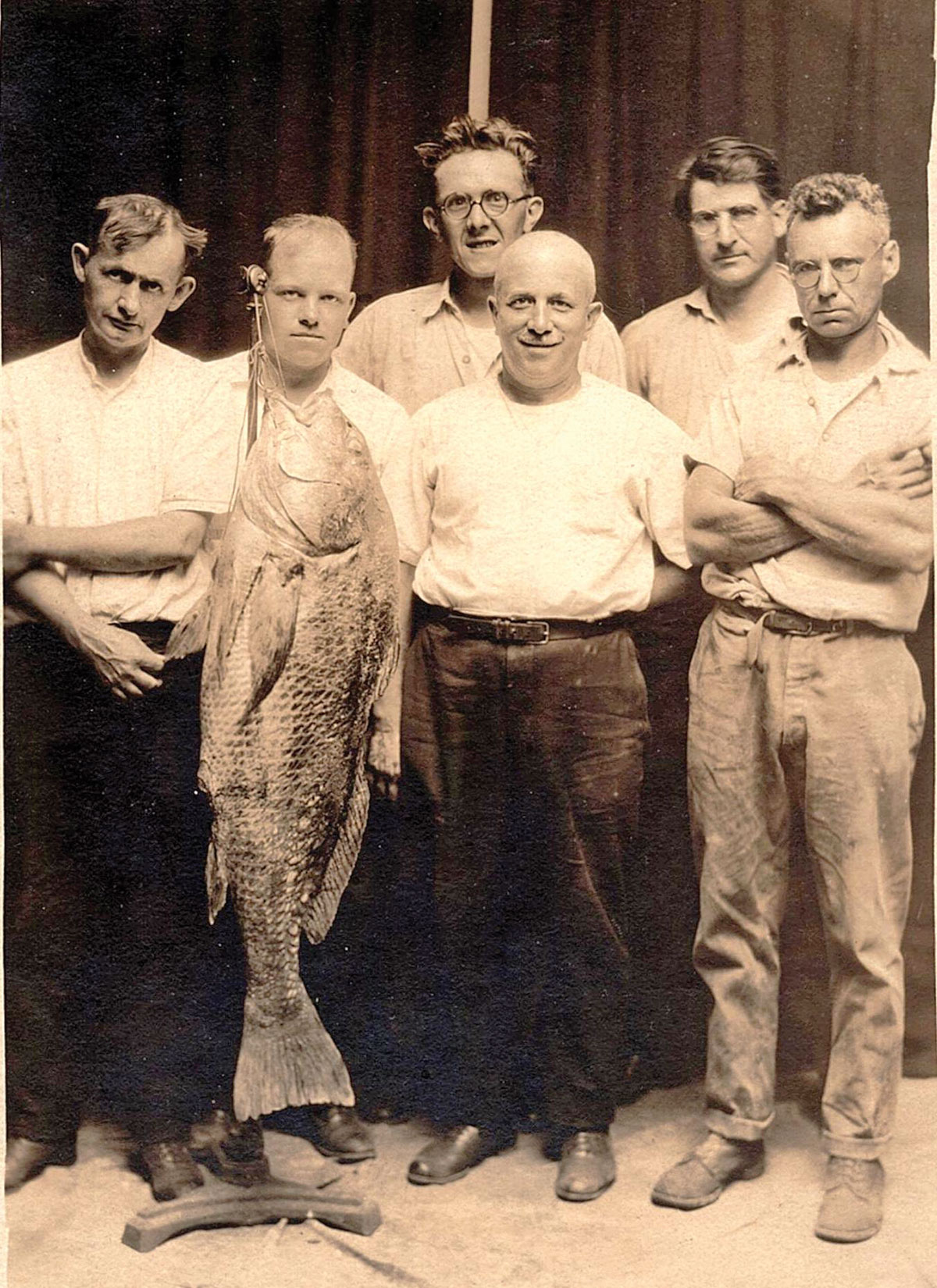
Drum Roll Please
The Fisherman has partnered with friends at PENN and Unsinkable Polarized help kick start the spring run of black drum, with the first annual Black Drum Battle. First place grand prize is a $2,200-prize package that includes an eight-hour black drum charter in 2020 with Capt. Bob Cope aboard Full Ahead Sport Fishing, a pair of PENN Fathom reels and a pair of PENN Rampage 7-foot rods, two 300-yard spools of Spider Wire Ultra Cast, two 100-yard spools of Berkley Pro Spec fluorocarbon leader, and one set of Unsinkable Polarized sunglasses.
Open to subscribers and non-subscribers alike, to qualify for the grand prize a black drum of at least 20 pounds must be caught on rod and reel within New Jersey or Delaware marine waters, and must be weighed and measured (length and girth) at one of the participating tackle shops, which are designated an official Fisherman Magazine Weigh Station. One second prize winner will receive a pair of PENN Squall star drag combo outfits, a pair of 300-yard spools of Spider Wire Blue Camo and a pair of Unsinkable Polarized sunglasses.
Those who aren’t subscribers have to register for the tournament first; it’s free and can be done online by visiting www.blackdrumbattle.com and agreeing to the official rules prior to fishing. After you’ve registered in the Black Drum Battle and then caught your big boomer, the fish weight and measurement must be entered on an official entry form, signed and dated, by the tackle shop’s authorized personnel, with photo of you and your qualifying fish submitted along with the Official Entry you’ll find at the official Fisherman Magazine Weigh Station. The contest entry period begins at 12:01 a.m. on May 1, 2019 and ends at 11:59 p.m. on June 30, 2019.
If you are a current subscriber to The Fisherman Magazine, you’re already entered into the contest, and you could also win $500 cash prize on top of the first place prize package if your black drum tops them all. The contest is open to residents of Connecticut, Delaware, Maine, Massachusetts, New Jersey, New York, Pennsylvania and Rhode Island, though employees of The Fisherman, sponsors, promoters and any prize providers are not eligible to enter or win. Contest is only open to those not currently employed in the fishing industry (commercial or for-hire captains and crews are excluded, as are tackle shop owners and staffers, marina owners and staff, outdoor writers, and those who work in the sportfishing and marine industry). Full contest rules can be found online at TheFisherman.com or BlackDrumBattle.com.
On the Meat
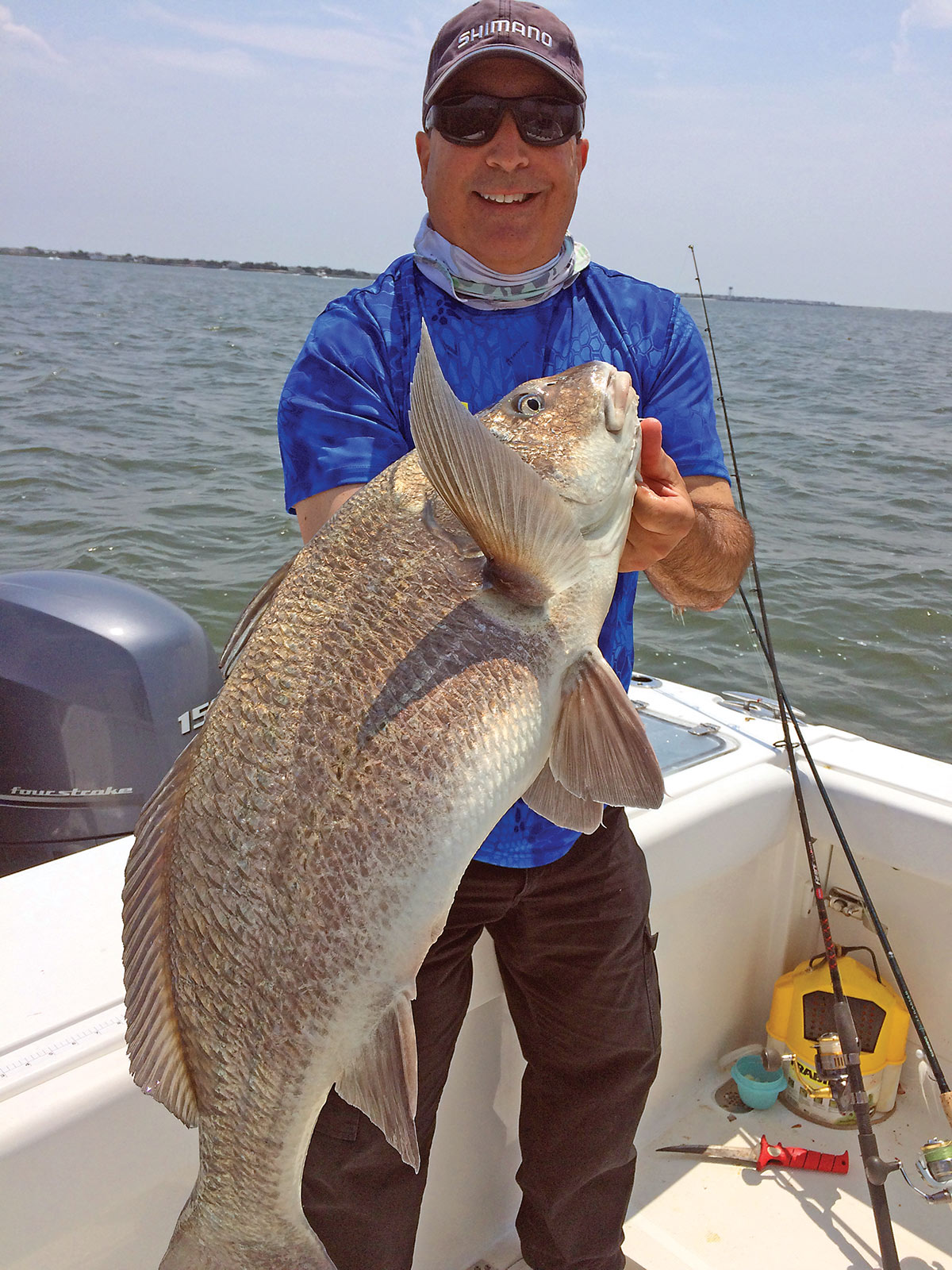
“Adult black drum are found to be a blackish or grayish color, but juvenile fish have distinctive dark stripes over a grey body,” said Freeman, describing drum as being a bottom feeder that “has a mouth with a downward orientation and a strong jaw with rounded teeth used to crush mollusk, crab, shrimp and a variety of aquatic vegetation.”
Like the cownosed rays whose population has exploded in recent years, schools of black drum have been known to make short work of local clam and oyster lots, rooting around the bottom and crushing up top necks and cherrystones harvested by local clammers. While fresh clam is the most popular bait for most of the Delaware Bay fleet, drum are just as apt to suck down squid, shrimp, bunker and crab.
Late last summer while poking around out back around Great Bay in search of sheepshead, triggers and tautog, I had more regular success with smaller, puppy drum to 10 pounds or so while using shedder crab on jigs straight up and down along the sod banks. That wasn’t the first time with shedder success; about 10 years ago while fishing with Capt. Chris Dollar on the Chesapeake, soft crabs were the bait of choice for working over the rock bed for good-sized black drum. Where most of us northerners anchor up for the boomers, Dollar and others use their fishfinders to hunt down and identify the big bladders on those drum, dropping a bait down as soon as they pop up on the screen. Shedder of course is an outstanding bait for the drum’s croaking cousin, the weakfish.
For Black Drum Battle contestants looking for that triple-digit boomer, a stout rod (medium-heavy) in the 7-foot range with fast action and strong backbone is the way to go. Braided line in the 35-pound range is a must for the sometimes light bite of the drum; braid is especially useful when fishing the deeper, swifter currents of Delaware Bay at perennial hotspots like the Pin Top or Tussy’s. For much of the season throughout the Garden State where 10- to 30-pound drum are more likely to be encountered, a medium outfit with 20-pound braid is more than sufficient.
If drum are tentative in their hits, a J-hook is preferred by many anglers who hold their rods while waiting for a chance to strike at a good fish. I’ve found that big circle hooks are just as effective when multiple rods are in the holder while fishing at anchor; this is especially true where I fish many of the shallower waters of Little Egg and Great Bay in the spring where the drum seem to be more aggressive in picking up and running with baits. As such, I have found larger circle hooks in the 9/0-range using 50-pound fluoro leader and a standard fish-finder rig to be perfectly suited for this fishery, though I plan to use a heavier spin outfit this spring with crab jig while anchored with multiple rods set out, just based on last summer’s success out back.
According to the Atlantic States Marine Fisheries Commission (ASFMC), the coastwide black drum stock is not overfished and not experiencing overfishing; while median biomass based on a 2015 stock assessment has been declining slowly, it is still estimated to be well above that necessary to produce maximum sustainable yield. New Jersey and Delaware both have a three fish bag and 16-inch size limit with no closed season.
In fact it’s robust enough that fish have continued to be found every year in some of the most surprising situations. Last spring, Arthur Depeine and his wife Ervia were plugging for stripers on Raritan Bay in their aluminum jon boat when they hooked up with a monster drum that bent trebles and nearly capsized their skiff after a 15-minute battle. Arthur called it a “scary and exciting best time ever.”
From the Raritan to the Delaware and every coastal beach and bay in between, such a battle in 2019 could snare you a few thousand dollars in prizes, just for banging the drum!
